At present, the global medical electronics industry is gradually showing attractive development prospects, and the speed of product replacement is constantly increasing. At the same time, due to the particularity of medical electronic products, the performance, power consumption, reliability and integration of components All parties have put forward extremely high requirements. The world's major semiconductor manufacturers have launched a series of products suitable for this application field.
The 32-bit embedded microprocessor (MPU) based on the ARM core, with its high performance, low power consumption and abundant on-chip resources, has become the first choice for many medical electronic product development platforms. Among them, Cirrus Logic's flagship product EP9315 is currently the most integrated ARM processor. The processor uses the ARM920T core, has a high performance of 200MHz frequency, embedded math coprocessor, graphics acceleration engine, integrated rich peripheral circuits including IDE and PCMCIA interfaces, meeting industrial-grade standards and very attractive The powerful price-performance ratio makes it stand out among many embedded microprocessors, making it an ideal choice for the next generation medical electronic product development platform.
Application requirements
There are many types of medical electronic products with different functions. Classified according to its application occasions, including ultrasound imaging system, multi-parameter monitoring system, conventional inspection system, etc.
Today's medical electronic products always use the latest technology in order to obtain powerful performance to complete increasingly complex algorithms and numerous functions to meet the needs of escalating clinical applications. Its application requirements are mainly manifested in the following aspects:
1. With the gradual improvement of product performance, hardware is required to complete a large number of algorithms and logical operations. Products such as ultrasound and high-end monitors have begun to use FPGA devices in large quantities;
2. Wide application of large-size display and touch screen. At present, ultrasound products, multi-parameter monitors and some inspection products such as hemocytometers, biochemical analyzers, etc. mostly use large-size displays in the range of 10 '~ 15', using 6? 0 & TImes; 480,800 & TImes; 600 or 1024 & TImes; 768. Resolution. In addition, touch screens are more and more widely used in this field;
3. Storage of large amounts of data. Due to the increasing size of application layer software and the need for deep image storage, products such as B-mode ultrasound and color ultrasound have begun to connect standard IDE hard drives;
4. The need for peripheral interfaces. Such as network interface and USB interface are indispensable in medical electronic products;
5. Application of Audio Codec. For example, in the color Doppler ultrasound system, audio codec is needed to complete the encoding and decoding of Doppler bloodstream audio data;
6. The advent of portable products has increased the focus on power consumption.
The above-mentioned series of application requirements put forward higher requirements on the microprocessor platform. When selecting a model, engineers often want faster speed, higher integration and lower power consumption. The convenience and reliability of design work, and can effectively control costs.
The unique advantages of EP9315
The microprocessor is the core control device of the system, and its indicators are often the engineers' most concerned when selecting the type. Compared with other embedded microprocessors based on ARM9 core, Cirrus Logic's EP9315 has obvious advantages in terms of overall performance, on-chip peripheral interfaces, and system cost. The block diagram of EP9315 is shown in Figure 1.
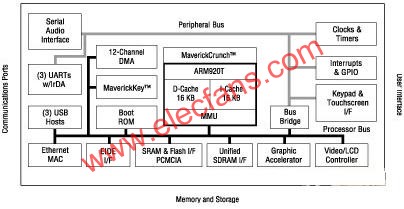
The indicators of EP9315 are as follows:
1. Integrated ARM920T core clocked at 200MHz and memory management unit (MMU) supporting Linux, Windows CE and many other embedded operating systems. Has 16KB instruction cache and 16KB data cache;
2. The embedded MaverickCrunch math coprocessor significantly improves the operation speed of single / double precision integer and floating point, which is helpful for the calculation of complex algorithms. This is very rare in other ARM microprocessors;
3. Integrated 2D graphics acceleration engine, through block copy, block filling and other operations to enhance the system's image processing capabilities. The image acceleration engine is independent of the microprocessor and does not increase system overhead. It can support up to 1024 & TImes; 768 resolution, which basically meets the large-size screen application of most medical electronic products;
4. Rich on-chip / peripheral interface resources can fully meet the current application requirements of various medical electronic products. From Table 1, we can see the parameters of Cirrus Logic's full range of ARM9-based microprocessors.
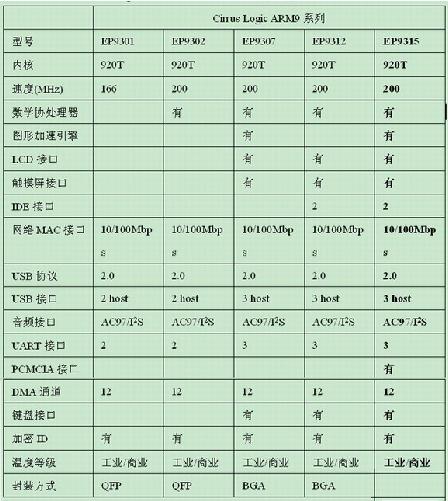
System design and Cirrus Logic complete technical support
In order to cooperate with the simultaneous development of customers, shorten the research and development cycle, and improve the design quality, Cirrus Logic specially set up a technical support center composed of more than 20 engineers in Beijing, responsible for the hardware and software technical support of EP93xx series products. It can not only provide design reference such as development board, but also provide a large number of software support services, including BSP source code, driver source code and complete kernel source code and development toolkit for Linux platform. Peter, General Manager of Cirrus Logic China and Hong Kong, said: "We not only provide chips for customers, but more importantly, we can provide a full range of solutions and technical support in development. There is no doubt that this will reduce the difficulty of customer development. Great help. "
Successful examples
At present, some companies have selected EP9315 as the processing platform of the system. The hardware designer of Emperor Company said: "We chose EP9315 as the platform for B-mode ultrasound system upgrade, mainly focusing on the following three points: 1. Integrated math coprocessor, compared with the same type of products, the algorithm processing speed will be much faster; 2 . Support high resolution, meet the requirements for image display, without adding an additional video codec chip; 3. Provide IDE interface, because the hard disk and DVD drive will be used in B-mode products. "
Shenzhen Adecon, which develops multi-parameter monitor products, has also used this chip in large quantities. The chief engineer believes that EP9315 has the reliability of industrial-grade chips, which is extremely important in medical equipment; in addition, perfect technical support is also the pre-development work Removed obstacles.
EP9315 provides two models of commercial grade and industrial grade (Table 2), and also provides lead-free products.

Product solution
product information:
The EDB9315A Engineering Development Kit (EDB9315A Kit) includes:
1. EDB9315A Development Board
2. RS-232 serial cable (Null-Modem system)
3. Switching power supply: + 5V, 4A, 110V / 220V compatible
4. "Quick Start Guide" (Quick Start Guide)
5. Product Registration Card (Registration Card)
6. IDC10-to-DB9 conversion cable
7. IDE hard disk cable
8. 3.5 "-to-2.5" notebook hard drive adapter
9. Hard disk power adapter (2x1 Header to HDD Power Connector Adapter)
10. Microsoft WinCE 5.0 Platform. Builder development environment CD
11. ARM RealView Suite development environment CD
12. IAR Development Environment CD
13. EDB9315A development board system CD (EDB9315A system resource CD), including:
EDB9315A development board documentation
EDB9315A development board schematic
EDB9315A software [including WINCE5.0 platform BSP source code, driver source code, and LINUX platform complete LINUX 2.6.8.1 kernel source tree (including QT / Opie development kit), development kit under Linux]
EDB9315A development board resources and interfaces:
1. Cirrus Logic highly integrated ARM9 SOC chip: EP9315, clock frequency: 200MHz
2. SDRAM: 6? MByte
3. FLASH: 16MByte NOR flash Memory
4. USB HOST: 2 USB 2.0 full speed host ports
5. USB DEVICE: 1 USB 2.0 high-speed slave port
6. Audio output (Audio Out)
7. Audio input (Audio In)
8. Serial port: 3 UART serial ports
9. Ethernet: 10/100 Ethernet interface
10. VGA video output interface
11. IDE hard disk CD interface
12. JTAG debug interface
13. Infrared interface: Consumer IR (CIR)
14. Onboard bus and IO expansion interface (Expansion Connectors)
15. LCD Interface and Touch Screen Support (LCD Interface with Touch Screen Support)
A. EP9315 processor
B. Processor status indicator: one green and one red
C. USB 2.0 high-speed slave interface IC (ISP1581)
D. SDRAM-2 16-bit SDRAM granular ICs
E. Storage bus expansion interface
F. Main power switch
G. 5V power input connector
H. 3.3V power output chip, 3A
I. Serial port start button-mark: "SERIAL BOOT"
J. Reset button-mark: "/ POR"
K. UART2 connector-5x2
L. UART1 connector-5x2
M. UART1-DB9 male
N. USB slave device connector (used to connect PC)
O. Ethernet connector
P. Dual USB host port connector (used to connect USB slave devices such as mouse, keyboard, U disk, camera, printer, etc.)
Q. Audio output connector
R. Audio input connector
S. Device bus expansion interface
T. Touch screen connector
U. JTAG emulator connector
V. VGA output connector-DB15 female
W. LCD connector
X. IDE connector
Y. IDE + 5V power supply (used to output power to the hard disk)
Z. Infrared communication transceiver (IR)
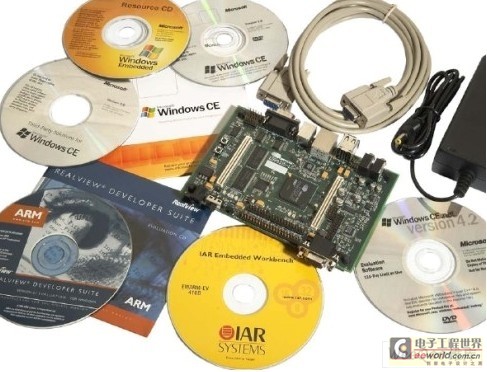
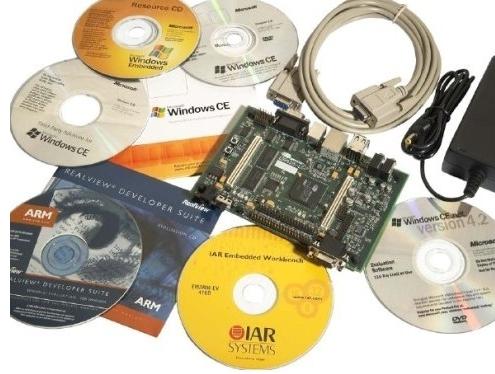
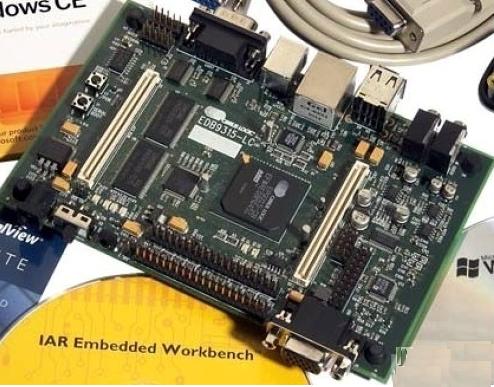
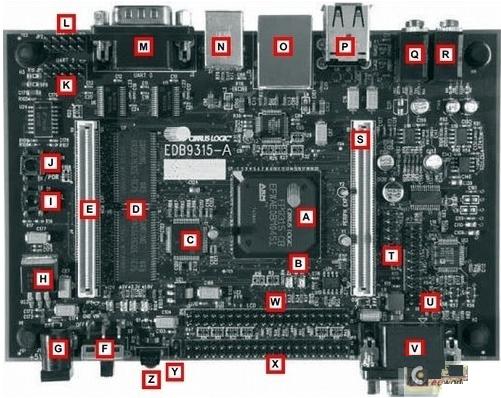
Usb4 80Gbps Data Cable,Tpe Pd Fast Cherger Cable,Thunderbolt4 80Gbps Data Cable,High-Speed Data Cable
Dongguan Pinji Electronic Technology Limited , https://www.iqdatacable.com